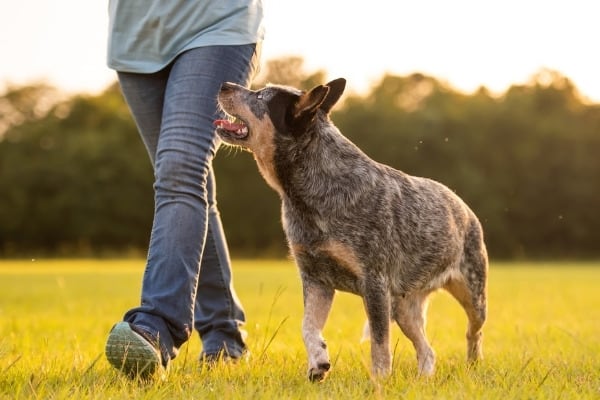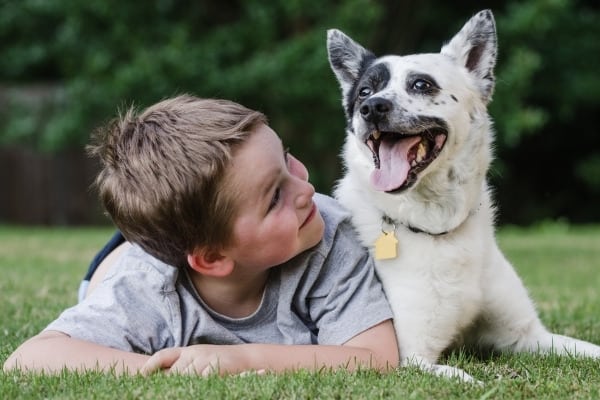
Blue Heelers were initially bred as working dogs, but they also make great family pets.
Their natural instinct to protect and be around other animals can make them very socially dependent on their owners.
The breed can suffer from separation anxiety, and many Blue Heelers have a habit of following their owners around everywhere they go.
With proper training and adequate socialization, these bad habits can be corrected.
Why does my blue heeler follow me everywhere? Blue Heelers are very social and loyal to their owners. They are also prone to separation anxiety. If your Blue Heeler is following you everywhere, he may be doing so to protect you, he may be lacking confidence, or you may be inadvertently reinforcing the behavior.
If you are planning to adopt a Blue Heeler, make sure you understand their socialization needs and are prepared to train them properly.
Read on to learn more about the training and socialization needs of this breed.
10 Reasons Why Your Blue Heeler Follows You Everywhere
Blue Heelers do not like to be by themselves. They are bred to be herding dogs and are used to having the company of a flock. They also have an instinct to protect their owners.
Here are 10 reasons why your Blue Heeler may be following you everywhere.
1. It’s in the Genes
Blue Heelers are naturally social and prefer to be with their owners as much as possible. They were originally bred to work closely with people, and this trait is still quite evident in today’s dogs.
2. Separation Anxiety
Many dogs suffer from separation anxiety, and Blue Heelers are known for being prone to it. Your Blue Heeler may be following you around because he is afraid you will leave him alone.
3. Lack of Exercise
Exercise is a requirement for Blue Heelers. They are full of energy and need to be able to run and play for long periods each day.
If they do not get adequate exercise, they may pace or follow you around to get some of their energy out.
4. Boredom
When a Blue Heeler is bored, he will look to his owner for entertainment. Your Blue Heeler may follow you, hoping you will take him outside or play with him.
5. Views You as Leader of the Pack
Blue Heelers appreciate pack rank, and a well-trained Blue Heeler will see you as the leader of the pack. He may follow you around, waiting for you to give him a command or task.
6. Strongly Bonded to You
The breed is known for being very loyal and affectionate to their owners. Your Blue Heeler likely follows you because he feels a close bond to you and wants to be with you as much as possible.

7. You Reinforce the Behavior
If you allow your Blue Heeler to follow you around or even ask him to come with you every time you go into another room or a different place, it will only reinforce the behavior and tell your dog that it’s okay for him to follow you around.
You can also be reinforcing the behavior if you pet him or interact with him at all when he compulsively follows you. He will quickly learn that if he’s always by your side, you’ll give him lots of attention.
In a way, he has effectively trained you in this regard.
8. Needs More Confidence/Socialization
Your Blue Heeler may follow you around because he feels lonely or doesn’t feel confident enough to be by himself.
Proper socialization will teach your dog how to act around other people and dogs so that he will be less dependent on you and more confident in any situation.
9. Naturally Loyal and Protective
Blue Heelers are naturally loyal and have the instinct to protect their families. Your dog may follow you to ensure you are safe.
10. Health Issues
When dogs are sick and suffering from health issues, they want to be close to their owners.
Your Blue Heeler may be following you to let you know he isn’t feeling well or just because being near you helps him feel better.
How To Help Your Blue Heeler Become More Independent
If you want to make your Blue Heeler more independent, you will have to train him. Consider some of these suggestions.
Socialization
If your dog is properly socialized, he won’t be shy around other people or animals, and he won’t cling to you for attention.
He will be able to interact with other people and animals more freely and will be confident enough to not mind being alone for short periods.
Training
Blue Heelers are easy to train, but they must have boundaries if they are going to be independent.
Make boundaries clear during training so your Blue Heeler will know when it is acceptable to follow you and when it isn’t.
It’s fine to use food rewards during training, but be sure that the treats are low in calories and about the size of a piece of kibble – these natural tidbits are perfect – to prevent weight gain.
- Zuke’s Mini Naturals With Added Vitamins And Minerals Beef Recipe, Soft And Chewy Dog Treats...
- With only 2 calories per treat, Zuke's beef recipe dog treats are dog treats that are great for...
Reassurance
If your dog seems to be following you due to separation anxiety, you should offer plenty of affection and reassurance so he knows you will come back even when he can’t follow you.
Just be sure not to coddle your dog as this reinforces your dog’s mindset that he needs you close by in order to be okay.
Related Questions:
Why Is My Blue Heeler So Clingy?
Blue Heelers are clingy by nature and are prone to separation anxiety. They cling to their owners as a way to feel close to them and due to their natural instinct to protect them.
What Breeds Make a Blue Heeler?
The Blue Heeler breed originated from a mix of collies, dingoes, and different herding dogs. The breed was developed in Australia in 1840 by a man named George Elliott.
Conclusion
Blue Heelers make great family pets, but they are prone to separation anxiety and like to cling to and follow their owners everywhere.
This behavior can be corrected with proper training. It’s also important to rule out any health issues that may cause your dog to be more clingy than usual.
Last update on 2024-04-19 at 20:03 / Affiliate links / Images from Amazon Product Advertising API





